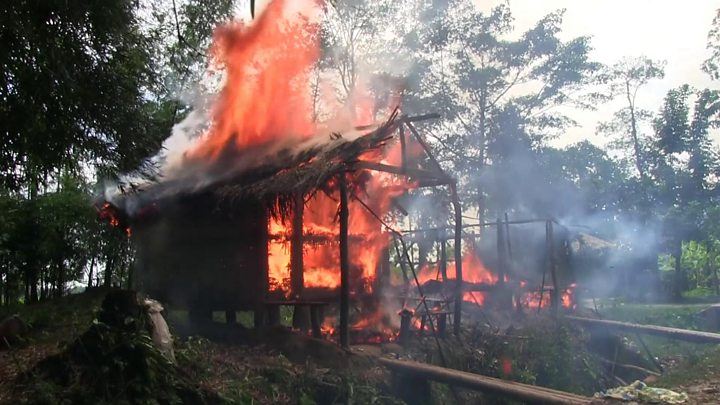 Media caption
Media caption
The 300,000 people who have fled Rakhine state to Bangladesh over the past two weeks all come from the northern districts of Maungdaw, Buthidaung and Rathedaung, the last areas of Myanmar with sizeable Rohingya populations not confined to displacement camps.
These districts are hard to reach. Roads are poor, and the government requires permits to go there, which journalists rarely get.
So we grabbed the opportunity to join a government-organised visit to Maungdaw, for 18 local and foreign journalists.
It would mean seeing only places and people they wanted us to see. But sometimes, even under these restrictions, you can glean valuable insights.
Besides, the government has arguments that need to be heard. It is now facing an armed insurgency, albeit one some would argue has been self-inflicted. The communal conflict in Rakhine state has a long history, and would be difficult for any government to deal with.

On arrival at Sittwe, the Rakhine state capital, we were given instructions. No-one was to leave the group and try to work independently. There was a curfew at 6pm, so no wandering after dark. We could request to go to places that interested us; in practice we found such requests were rejected on grounds of security. To be fair, I believe they were genuinely concerned for our safety.
Most of the travel in this low-lying region of Myanmar is along the maze of creeks and rivers on crowded boats. The journey from Sittwe to Buthidaung takes six hours. From there we travelled for an hour on a rough road over the Mayu Hills to Maungdaw. As we drove into the town we passed our first burned village, Myo Thi Gyi. Even the palm trees were scorched.
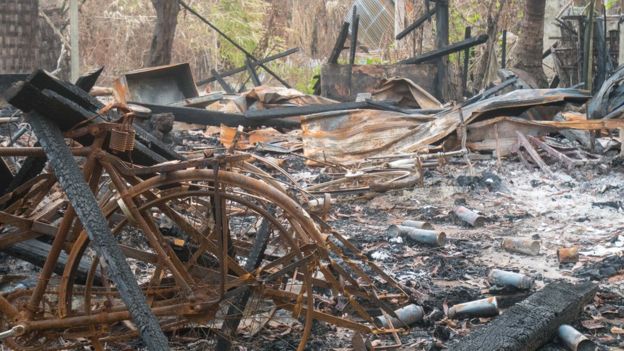
The government's purpose in bringing us was to balance the overwhelmingly negative narrative coming from the Rohingya refugees arriving in Bangladesh, who have almost all spoken of a deliberate campaign of destruction by the Myanmar military and Rakhine mobs, and appalling human rights abuses.
But right away these efforts faltered.
We were first taken to a small school in Maungdaw, now crowded with displaced Hindu families. They all had the same story to tell of Muslims attacking, of fleeing in fear. Oddly, Hindus who have fled to Bangladesh all say they were attacked by local Rakhine Buddhists, because they resemble Rohingyas.
In the school they were surrounded by armed police and officials. Could they speak freely? One man started to tell me how soldiers had been firing at his village, and he was quickly corrected by a neighbour.
A woman in an orange, lacy blouse and distinctive grey and mauve longyi was especially animated about the abuses by Muslims.

We were than taken to a Buddhist temple, where a monk described Muslims burning down their own homes, nearby. We were given photographs catching them in the act. They looked strange.
Men in white haji caps posed as they set light to the palm-thatch roof. Women wearing what appeared to be lacy tablecloths on their heads melodramatically waved swords and machetes. Later I found that one of the women was in fact the animated Hindu woman from the school, and I saw that one of the men had also been present in among the displaced Hindu.
They had faked the photos to make it look as though Muslims were doing the burning.
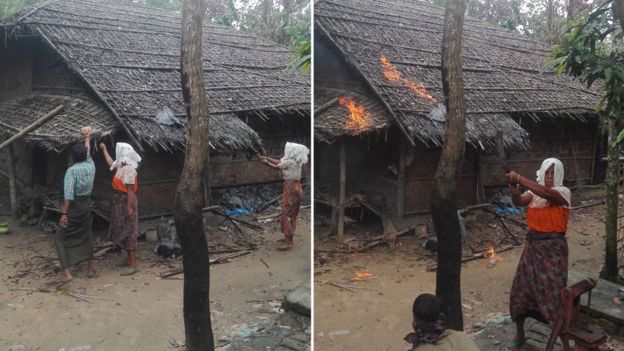 BBC / HANDOUT
BBC / HANDOUT
We had an audience with Colonel Phone Tint, the local minister for border security. He described how Bengali terrorists, as they call the militants of the Arakan Rohingya Salvation Army, had taken control of Rohingya villages, and forced them to offer one man per household as a fighter. Those who refused to comply have their houses burned, he said. He accused the militants of planting mines and destroying three bridges.
I asked whether he was saying that all of the dozens of burned villages had been destroyed by the militants. He confirmed that was the government's position. Responding to a question about military atrocities, he waved it away. "Where is the proof?" he asked. "Look at those women," he meant the Rohingya refugees, "who are making these claims - would anyone want to rape them?"
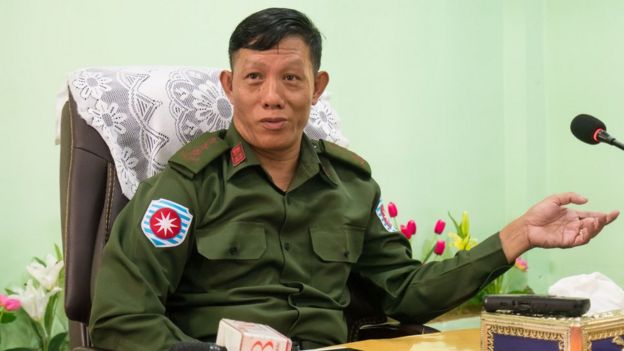
The few Muslims we were able to see in Maungdaw were mostly too scared to talk in front of a camera. Breaking away from our minders, we spoke to some who described the hardship of not being allowed to leave their neighbourhood by the security forces, of food shortages, and intense fear.
One young man said they had wanted to flee to Bangladesh, but their leaders had signed an agreement with the authorities to stay. In the now quiet Bengali market, I asked a man what he was frightened of. The government, he said.
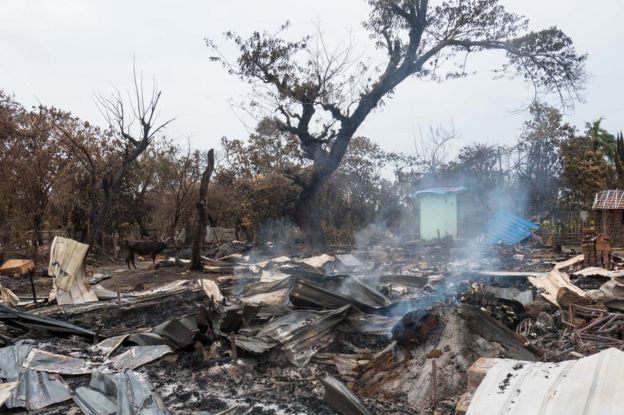
The main destination on our itinerary outside Maungdaw was the coastal town of Alel Than Kyaw. This was one of the places attacked by Arsa militants in the early hours of 25 August. As we approached, we passed village after village, all completely empty. We saw boats, apparently abandoned, along with goats and cattle. There were no people.
Alel Than Kyaw had been razed to the ground. Even the clinic, with a sign showing it had been run by the charity Medecins Sans Frontieres, had been destroyed. To the north, in the distance we could see four columns of smoke rising, and heard bursts of automatic weapons fire. More villages being put to the torch, we guessed.

Police Lieutenant Aung Kyaw Moe described to us how he had been given advance warning of the attack. He had taken the non-Muslim population for protection into his barracks, and his men fought off the assailants - armed, he said, with guns, swords and home-made explosives, for three hours until they were driven off. Seventeen of the militants lay dead, and one immigration officer. The Muslim population fled shortly afterwards.
But he struggled to explain why parts of the town were still smouldering, two weeks after the attack, and in the rainy season. Perhaps a few Muslims stayed on, and then set their homes alight before leaving more recently, he suggested half-heartedly.
Then, on our way back from Alel Than Kyaw, something entirely unplanned happened.
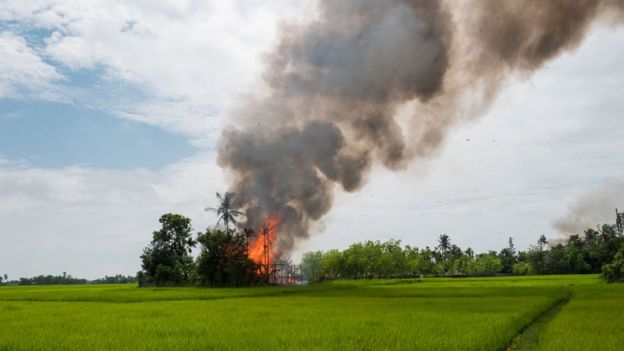
We spotted black smoke billowing out of some trees, over the rice fields. It was another village going up, right by the road. And the fires had only just started. We all shouted at our police escort to stop the van. When they did, we just ran, leaving our bewildered government minder behind. The police came with us, but then declared it was unsafe to enter the village. So we went ahead of them.
The sound of burning and crackling was everywhere. Women's clothing, clearly Muslim, was strewn on the muddy path. And there were muscular young men, holding swords and machetes, standing on the path, baffled by the sight of 18 sweaty journalists rushing towards them. They tried to avoid being filmed, and two of them dashed further into the village, bringing out the last of their group and making a hasty exit.

They said they were Rakhine Buddhists. One of my colleagues managed a quick conversation with one of them, who admitted they had set the houses on fire, with the help of the police.
As we walked in, we could see the roof of the madrassa has just been set alight. School texts with Arabic script had been thrown outside. An empty plastic jug, reeking of petrol, had been left on the path.
The village was called Gawdu Thar Ya. It was a Muslim village. There was no sign of the inhabitants. The Rakhine men who had torched the village walked out, past our police escort, some carrying household items they had looted.
The burning took place close to a number of large police barracks. No-one did anything to stop it.
BBC News
No comments:
Post a Comment